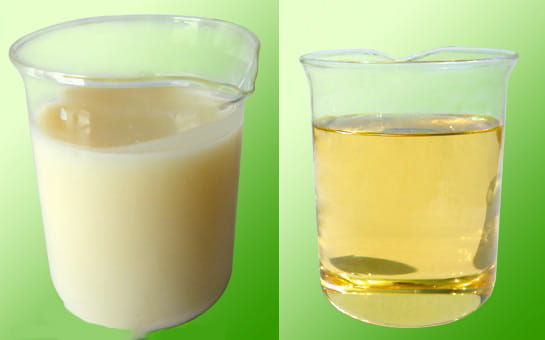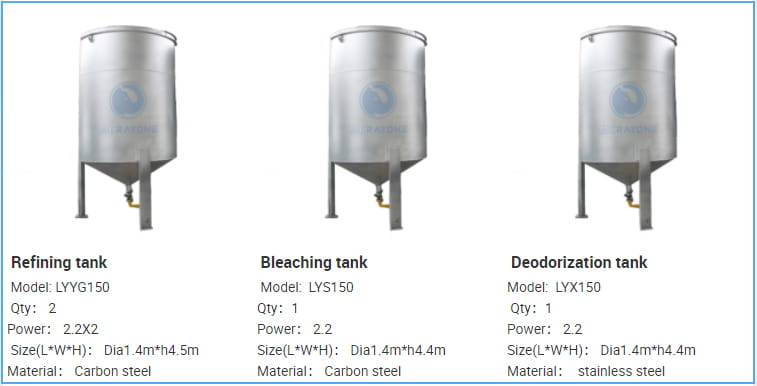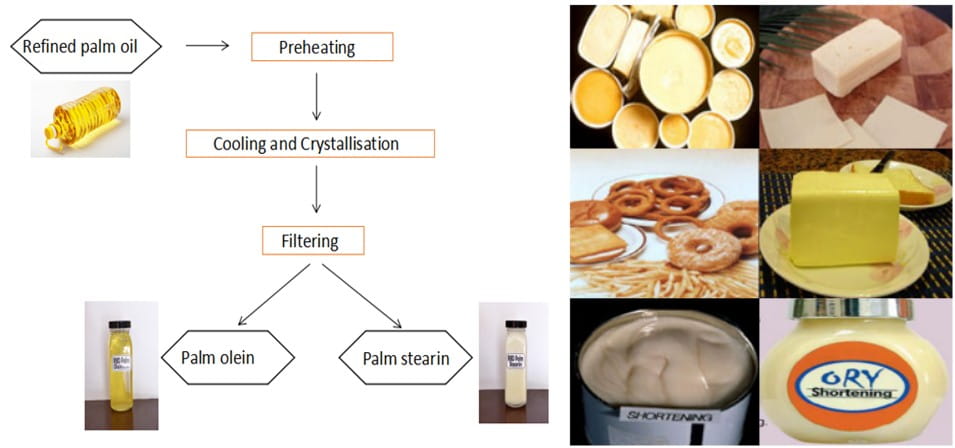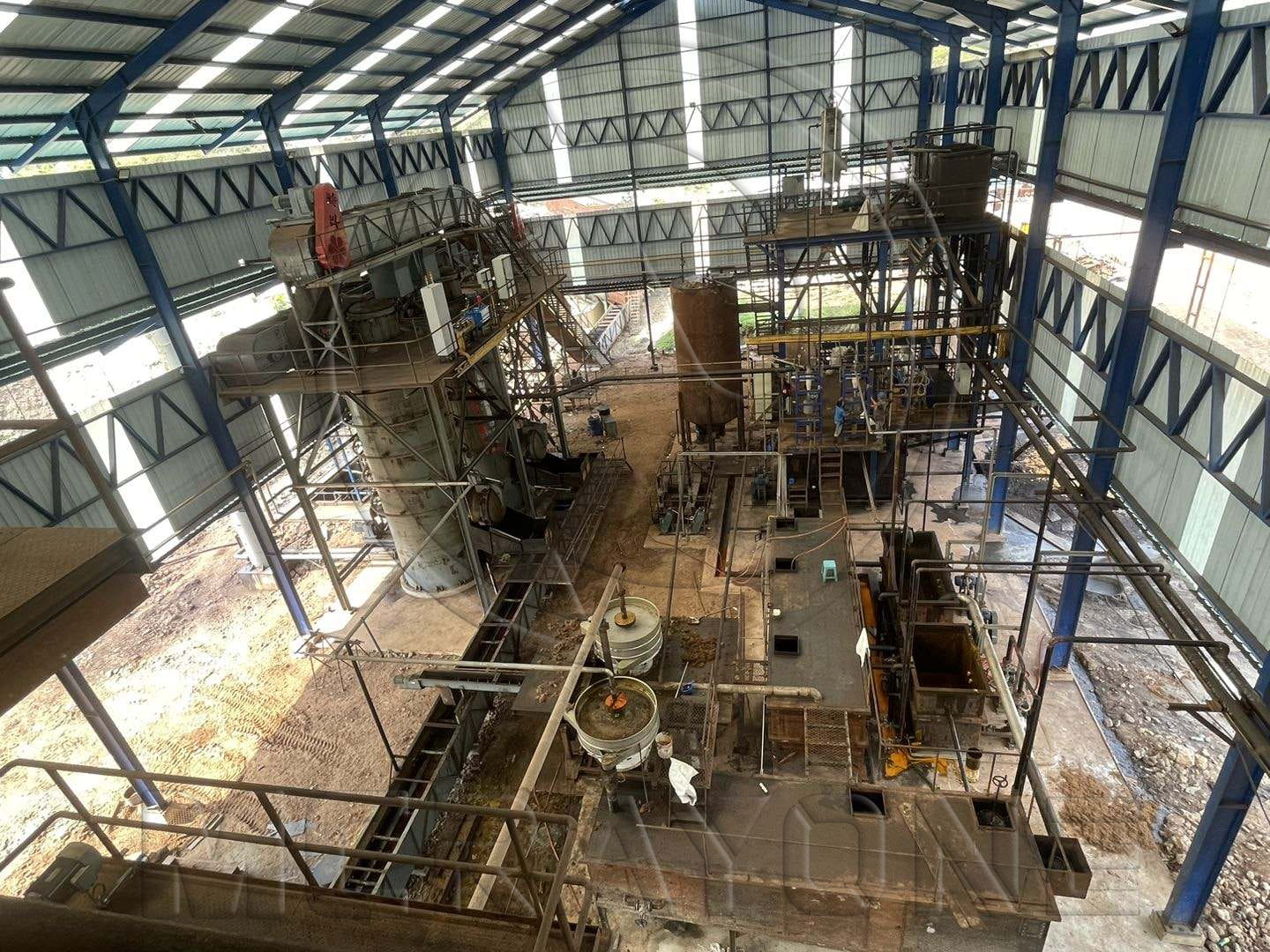Crude oil is refined and fractionated to obtain high quality oil. Fractionation can separate palmitate and stearin. Palm oil fractionation can be used to obtain palm oil products with different melting points such as 8 degrees, 10 degrees, 14 degrees, 18 degrees, 24 degrees, 33 degrees, 44 degrees, and 55 degrees.

The Basic Refining Process Follows:
1.Crude oil filtration
Raise the temperature of the crude oil to 30-32°C, and stir at a speed of 60 r/min to remove air bubbles in the oil. Add 0.1% to 0.2% phosphoric acid (0.5% industrial phosphoric acid by mass fraction) in oil and stir for about 30 minutes.
2.Degumming
Crude palm oil generally does not undergo degumming treatment alone. Although the phosphorus content is relatively low (generally less than 20PPM), it is best to add 0.05% phosphoric acid for degumming before decolorization, which helps to improve the stability and durability of the refined oil.
Neutralization by adding alkali (for example, if the neutralization process of alkali refining is used)
Alkali refining is carried out with 160 degrees of Baume, liquid caustic soda with a quality of 1.5% of oil quality and liquid caustic soda with an oil quality of 0.5%. First stir rapidly (60 r/min) for 10-15 min, then stir slowly (27 r/min) for 40 min.
Static precipitation
Neutralize and stir slowly for 40 minutes, then raise the temperature to 50-52°C, continue to stir at a slow speed for about 10 minutes, stop stirring after the oil and soap are separated, and turn off the indirect steam. Let it settle for about 6 h, and then separate the oil and soap.
2.Washing
Heat up the clean oil after soapstock separation to 85°C under stirring, then add saline water (containing 0.4% caustic soda and 0.4% industrial salt) with 15% oil quality and a temperature of 90°C. After adding water, the stirring was stopped, and the lower layer of wastewater could be released after standing for 30 min. After the waste water is exhausted, the oil temperature is still controlled at 35°C, and then sprayed with 15% boiling water (clear water). Also stop stirring after adding water, let stand for 0.5 h and then release the lower layer of wastewater. So wash 2 or 3 times.


3.Decolorization
Chromosomes are mainly various carotenoids and chlorophyll, and the above compounds form colored products through oxidation. In addition, the interaction between chromoplasts and oxidized oil often makes the oil brown. These chromoplasts and their oxidation products can be removed by a decolorization process.
Pre-decolorization: start the vacuum pump to suck the net oil after alkali refining into the pre-decolorization pot, and raise the temperature to 90°C. Dry and dehydrate under a vacuum of 99 kPa for 30 min. Then inhale a small amount of acid clay and stir for 20 min. After pre-decolorization, the oil is cooled to 70°C under vacuum, and then sent to a filter press with a gear pump for filtration.
4.Stripping and deodorization
Deodorization is the production process of removing unpleasant odor and taste substances from oil.
The principle of oil deodorization is based on the fact that under the same conditions, the vapor pressure of odorous components is much greater than that of triglycerides. Under the conditions of high temperature and high vacuum, a certain amount of superheated direct steam is introduced, the steam passes through the oil containing odor components, and the steam-liquid surface contacts, the steam is saturated by the odor components and according to the ratio of its partial pressure Spilling achieves the purpose of detaching odor components.
5.Fractionation
Fat is a mixture of various triglycerides. Those with high melting points exist in liquid form and are called "oil", while those with low melting point exist in solid and semi-solid form, usually called "fat". At a certain temperature, The process of separating oils and fats into different triglyceride components is called fractionation. Yushou oil fractionation equipment can be used to process vegetable oils such as palm oil, palm kernel oil, and cottonseed oil, and animal fats such as fish oil, tallow, and lard to increase the added value of oil products.
At present, the more mature method is dry fractionation, which is a more economical method. In this method, the oil in the dissolved state is slowly cooled to a certain extent, and then filtered to separate crystals and precipitate solid esters.
Basic process: palm oil→heating→cooling and crystallization→filtering→olein, stearin

Heating: palm oil is in a semi-solid state at room temperature, its saturated acid and unsaturated acid account for about 50% each, and the triglyceride composition is 8%~10% for GS3, about 48% for GS2U, and 35% for GSU2~ 39%, GU3 accounted for 7%~7.5%. Palm oil is first dissolved into a liquid state by heating, and the palm oil is generally heated to about 70 degrees before crystallization to destroy all existing crystals.
Cooling and crystallization: The key to the dry fractionation process is cooling and crystallization. If the crystallization is successful, the separation will be easy. The user sets the cooling curve according to the season and temperature, so as to obtain products that are in line with market sales.
During processing, cooling and crystallization conditions will determine the initiation of nuclear crystallization, the number of crystals and the size of crystals. Cooling efficiency and order are decisive factors for the unique formation and filterability of crystals.
The specific operation is to control the cooling process by setting the temperature difference between the oil and the cooling water and the cooling time under the state of stirring and circulating water cooling, forming crystal nuclei and growing slowly. When the required temperature is reached (depending on the quality of the desired soft fat, generally 20 degrees), stop cooling.
Filtration: After filtration, liquid oil and solid fat are obtained and stored separately. It is important to control the conditions of cooling and crystallization, but the selection of filtration equipment also has a great impact on the yield of liquid oil. There are several types of filtration systems currently used in industry: box filters and membrane filters.

Fractionated Palm Oil Parameters
58-degree palm oil:
Quality index: specific gravity: (60°C/20°C water) 0.882, saponification value mgKOH/g: 193, transparency: 80°C clear and transparent, smell, taste: palm oil inherent smell, good taste, color (Lovibon color cell 133.4mm ): Y30, R3.0, moisture and volatile matter %: 0.04, impurity %: 0.043, melting point ℃: 57.6, free fatty acid (calculated as palmitic acid) 0.25%, acid value mgKOH/g: 0.40, unsaponifiable matter %: 1.0, peroxide value meq/kg: 5.26, iodine value (Wechsler method): 40gI/100g. Fat content %: ≥99%, palmitic acid (C16:0) accounts for 67.056%, stearic acid (C18:0) accounts for 4.905%, oleic acid (C18:1) accounts for 17.116%, linoleic acid (C18: 2) accounted for 3.942%. The quality meets the requirements of GB15680-2009 standard, and can be widely used in the chemical industry. It can be used as raw materials for the production of soap, laundry soap, transparent soap, biodiesel, lubricants, papermaking additives, craft candles, hydrogenated oil, stearic acid, glycerin, etc.
52-degree palm oil:
Quality index:: (1) specific gravity: (70℃/25℃ water) 0.875 (2) hard price, gI/100g: 51 (3) saponification price, mgKOH/g: 189 (4) transparent smell, good taste (6 ) Color (Lovibond color cell 133.4mm): Y30, R3.0 (7) Moisture and volatile matter %: .07 (8) Impurity %: 0.09 (9) Melting point ℃: 52 (10) Acid value, mgKOH/g : 0.40(11) Unsaponifiable %: 1.0(12) Peroxide value, meq/kg: 10, Iodine value (Wechsler method): 40gI/100g.
44 degrees palm oil:
Quality index: (1) Specific gravity: (60°C/25°C water) 0.880 (2) Hard price, gI/100g: 53 (3) Saponification value, mgKOH/g: 187 (4) Transparency: Clear and transparent at 55°C (5 ) Smell, taste: gas 06 (8) impurity %: 0.05 (9) melting point ℃: 44 (10) acid value, mgKOH/g: 0.28 (11) unsaponifiable matter %: 1.0 (12) peroxide value, meq/ kg: 10.
33 degrees palm oil:
Quality index: (1) Specific gravity: (50°C/25°C water) 0.893 (2) Hard price, gI/100g: 54 (3) Saponification value, mgKOH/g: 184 (4) Transparency: Clear and transparent at 45°C (5 ) Odor, taste: Odor, 04 (8) Impurity %: 0.04 (9) Melting point ℃: 33 (10) Acid value, mgKOH/g: 0.18 (11) Unsaponifiable matter.
24 degrees palm oil:
Quality index: (1) Specific gravity: (40°C/25°C water) 0.902 (2) Iodine value gI/100g: 56 (3) Saponification value, mgKOH/g: 180 (4) Transparency: Clear and transparent at 35°C (5) Odor and taste: Good smell and taste (6) Color (Lovibond color cell 133.4mm): Y30, R3.0 (7) Moisture and volatile matter %: 0.03 (8) Impurity %: 0.03 (9) Melting point ℃: 24 (10) Acid value mgKOH/g: 0.16 (11) Unsaponifiable matter %: 1.0 (12) Peroxide value, meq/kg: 10. It meets the requirements of the new national food standard and can be widely used in the food industry.

